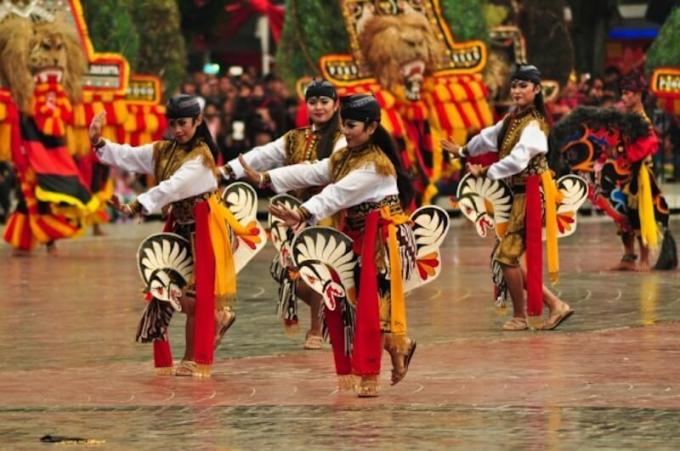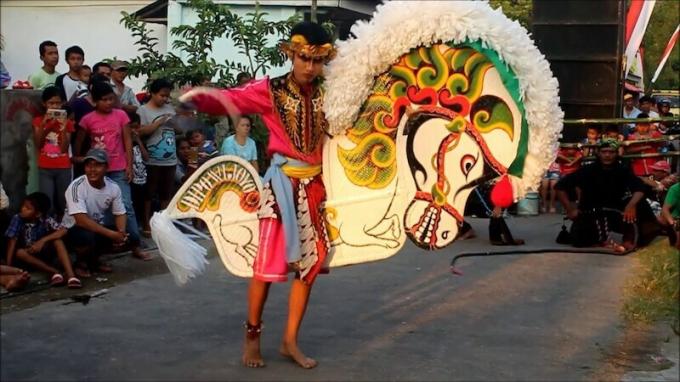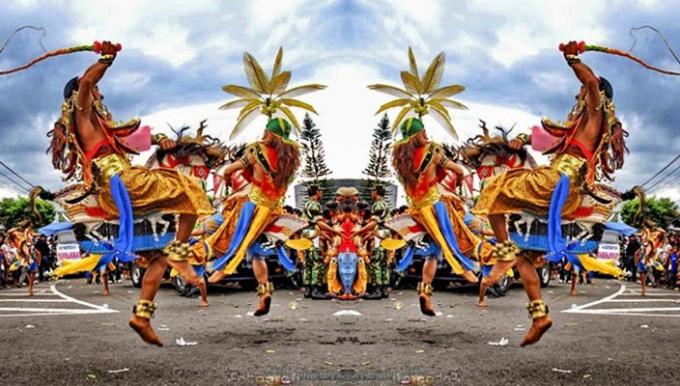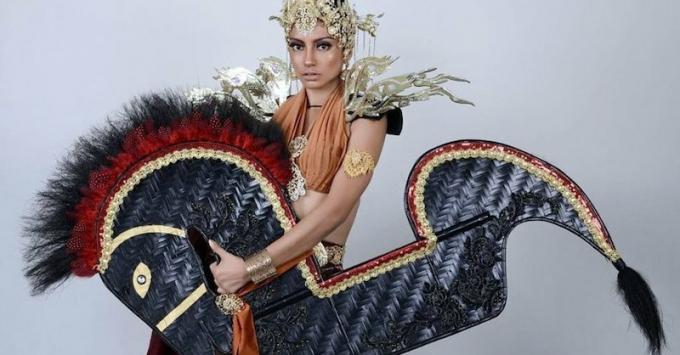Lumping Horse Dance: Origin, Properties, Uniqueness (Complete)
Loading...
Kuda Lumping dance is an Indonesian art that is quite popular. This dance art contains customs, cultures and ethnic groups that are contained in the unity of Mother Earth. The uniqueness of this dance is the most prominent part of the trance, but still under the control of a handler.
This dance is also often referred to as Jathilan which has the characteristic of being played by a group of people who dance using horse properties. This dance originating from Java uses properties specially designed for the dancers.
List of contents
History of Lumping Horse Dance

The origin of the emergence of this dance comes from East Java, but if we talk about the history of this dance, it is still said to be unclear or confusing. This is what makes the historical stories circulating in the community are quite diverse. Here are some versions of the history.
- Kuda Lumping has existed since primitive times where generally the dance is used in traditional ceremonies or rituals that are magical in nature. At first, the properties used were quite simple but changed over time.
- The lumping horse is a form of appreciation for the full support of the common people for the struggle of Prince Diponegoro and his horse troops in fighting and expelling the invaders.
- The lumping horse is an illustration of the struggle of Raden Patah and Sunan Kalijaga and their troops in an effort to expel the invaders.
- Kuda lumping describes the training process carried out by the Mataram Kingdom's war troops led by Sultan Hamengku Buwono I in an effort to face the Dutch.
- Kuda Lumping tells the story of a king who has very powerful powers who are in the land of Java.
Origin of Lumping Horse Dance Daerah

The art of Kuda Lumping originates from the Ponorogo area, East Java Province. This dance art shows the movement of a group of soldiers who are riding horses. All properties used are mostly made of wood including horses.
This traditional dance is also known as jaran braid. The main property in this art show is the horse which is made of comfortable and decorated by colored cloth. In the story, dancers are not just horsemen. But the show will be more interesting because of the mystical element.
Dancers will show immune skills such as eating glass, being whipped and so on. This movement is shown to be related to belief in the supernatural element. Generally, Kuda Lumping is a part of the Reog dance performance.
This dance is very popular and is often awaited by the audience. Not only in Indonesia, this traditional dance is also well known abroad.
Read: Regional Dance
Lumping Horse Dance Property

In the show, the lumping horse uses several supporting tools. The equipment used is identical to woven bamboo which is shaped into a mount similar to a horse. Dancers will ride horses while performing acrobatic stunts. Here are some of the properties used.
1. Long pants
The trousers used by the Kuda Lumping dancers hang slightly above the ankles.
It aims to make it easier for dancers when moving so that they seem agile. The upper part is equal to the hips will be covered with a scarf which is usually batik patterned.
2. Bracelet
Bracelets are used as decorative accessories. The bracelet motifs used are generally quite diverse, but what is often used is golden yellow. Bracelets are used by both male and female dancers during the performance.
3. Bamboo
In Kuda Lumping, bamboo is an important tool in the show. Later the bamboo will be woven and shaped like a horse. The results of the woven will be the mounts of the dancers when performing the action.
Currently, the horse used as a showpiece is not only made of bamboo, but can also be made of plastic so that it can save costs.
4. sideways
Sesumping is a decoration used on the dancer's ear. Not all dancers have to wear this property.
The golden color emitted from the sesumping will emit a shimmer of light. The shape of this tool is similar to that used in wayang orang performances.
5. Sock
Socks can be said as an additional tool. This happens because this property is not required to be charged. However, some groups of dancers still use it as an additional decoration and to avoid dangers that get out of control.
6. Vest
The vest is used as a layer between the inner shirt and Apok. Vests should only be worn by female dancers. The motifs used by each Paguyuban vary. It adapts to the characteristics and desires of each region.
7. Headband
Headband is an additional property that is not mandatory so it can be worn or not. The color of the headband used will match the overall color of the costume so that it looks harmonious.
Each dance group will use a different headband, especially when they have to perform together.
8. Apok
Apok is the final layer of cover after underwear and vests. The shape is very unique and specially made. Apol is symbolized as a symbol of the strength and valor of male dancers. Apok is placed on the chest until it spreads to the back.
9. Dress
The tops used by the dancers are quite diverse. However, the most commonly used are the brightly colored shirts and t-shirts. Tops will be lined with a vest and Apok.
10. Headgear
Head cover is a property used by female dancers. This property is a symbol of the protective headgear used by female soldiers who went to fight on the battlefield.
Although it is generally used by female dancers, it does not mean that male dancers should not use it.
11. Shawl
The scarf is used as a decorative belt that functions as a binder as well as additional decoration. As for the criteria, each Association may be different, both in terms of color, pattern, and motif. It can be adapted to the characteristics of each.
12. Imitation Machete
This property is used to show a symbol of people's resistance in ancient times against the invaders. Generally this property is made of wood which is decorated with paint.
The combination of paint used makes this property look original. The movements of the dancers when using machetes are seen on the battlefield.
13. Dark Glasses
Not as usual, sunglasses are used to overcome the sun. However, this property serves to cover the dancer's movements from being seen.
When performing, the dancer's eyes will change when in a trance. So that the audience can continue to enjoy the show and not be afraid to see it so that it is covered by glasses.
14. Decorative Belt
Decorative belt serves as a binder to strengthen all parts of the costume used. This property is also used as a belt.
Advertisement
The colors used are generally confirmed by the fashion used so that they look beautiful and harmonious. Generally, the decorative belt used is predominantly black.
15. Whip
Whips are also known as whips. Almost all dancers will use their own whips during the performance process. There are 1 or 2 whips that are up to 2 meters long.
Whips are special and when released on the surface will produce a loud and loud sound. This property will be the main attraction because it is able to attract the attention of the audience.
Read: Peacock Dance
Lumping Horse Dance Function

The uniqueness of the lumping horse makes this dance look attractive and popular among the public. Many viewers are curious about the mystical and cultural elements that are displayed in this cultural art.
Each regional dance carries several important functions in it that can be applied in everyday life, especially for the community as social beings. Check out some of its functions as follows.
1. Field of Trust
According to the beliefs of some regions, believing in the existence of the supernatural really does exist. In the staging of the lumping horse, this can be seen clearly and becomes its main characteristic. This is also what distinguishes this type of dance from other dances.
2. Field of education
The performance of the lumping horse depicts human nature which consists of good and bad. Many values and norms are channeled in this dance performance.
With this performance, dancers are able to invite people to be able to continue to do good, while still having common sense.
3. Social Affairs
Kuda lumping is a type of dance that is played in a complete way, starting with the handler, dancers, and musical accompaniment.
In order to create a maximum appearance, all elements must work well together. If one of them is negligent or makes a mistake, then the results may not be optimal.
4. Entertainment Field
Horse lumping art performances in various regions can be used as a means of entertainment for many people. The existence of a climax in the show makes the audience's enthusiasm to be even greater in enjoying each performance that is presented.
The Meaning of Lumping Horse Dance

Kuda Lumping is a show that carries mystical elements in it. The combination of the supernatural and comfortable is one of the things that stands out the most and makes the audience amazed. The attractions shown are beyond conscious human capabilities so that they are astonished.
Lumping horses are generally displayed in special events such as holiday celebrations, weddings, and so on. The supernatural part in the show that is often displayed is when the dancers exhibit the act of chewing glass, walking on glass, and others.
Uniquely, the dancers do all these things in a trance. However, behind the characteristics and unusual elements, Kuda Lumping is performed with several meanings as follows.
1. Describing Human Character
Even though this dance contains mystical and magical elements, it has meaning in it such as applying human nature and attitudes while in the world as if there are good and wicked.
This can be seen clearly at the beginning of the show, when the dancers are dancing gracefully and gently. However, when a supernatural spirit enters, the attitude and nature of the dancer immediately turns wild, violent, and difficult to control.
2. Belief in the Unseen World
The main characteristic of this dance is that it combines elements of the real with the supernatural. In this dance, the dancers prove to the audience that the Unseen Realm is not just a story, but it does exist.
This is proven when the dancer can be in a complete trance without any awareness. In addition, the courage of the dancers in performing attractions that are beyond the capabilities of ordinary humans cannot be done without the help of spirits with the permission of Allah SWT.
Read: Legong Dance
The Uniqueness of Lumping Horse Dance

The uniqueness of the lumping horse is in the use of a horse-shaped property made of bamboo. This dance feels very charming with the accompaniment of sinden singing and has a smooth and soft movement.
In addition, there is a mystical element that makes this dance look unique. Generally, mystical performances are performed like dancers who are in a trance, then perform a show of strength by showing their immunity.
Horse Lumping Dance Accompaniment Music

Almost all traditional dances use musical accompaniment to complete the dance movements from opening to closing. But there are also some who do not use it. Kuda Lumping itself uses several musical instruments as accompaniment.
Along with its development, this dance uses new creations that use additional musical instruments to make the sound of the dance accompaniment feel more cultural. Gamelan is the main musical instrument in a dance. Check out a brief explanation of the components of the gamelan instrument below.
1. Bonang
Bonang is also known as the forehead. Physically, the shape is not much different from Gong, only the size is much smaller. The size of the bonang is about the size of a dinner plate.
The location is also different, if Gong is generally hung vertically while Bonang is placed flat or horizontally.
Bonang is made of bronze or iron with wood as a bat made of munggur. In various dances and Minang culture, this bend is called Talempong.
2. drum
Kendang or drum is a mandatory musical instrument in the art of Kuda Lumping. If there is no drum, the musical accompaniment for the lumping horse feels incomplete, at least there are two types of drums used, namely Kendang Bem (Gedug) and Kendang Sabet.
The sound of the drums is dominant enough to give perfection to the musical accompaniment. This instrument can be a beat for dancers to make an interesting appearance.
3. Gong
Gong is a musical instrument made of bronze or iron. Circular shape and various diameters.
In the center there is a circle that will protrude forward almost like a split coconut shell that becomes the center to produce a sound when hit. The resulting sound is buzzing.
The types of gongs needed include Gong Suwukan and Gong Kempul. Both types of gong are mandatory and needed in the lumping horse performance.
4. Saron
Saron is made of brass, bronze, or iron. The shape of this tool is rectangular and flat, and is placed horizontally. The sound produced by this tool is similar to a bell but it rings.
The types of Saron used include Saron Pelog and Saron Slendro. For the number of blades, Saron with Laras Pelog generally has 7 blades, while Saron Laras Slendro has 7 blades, but some have 9 to 12 blades.
In addition to some of the tools already mentioned, several other musical instruments such as trumpets, bendes, and flutes can be added. These musical instruments can be used as an alternative to be able to adjust to the appearance and other considerations.
Read: Various Floor Patterns
Lumping Horse Dance Floor Pattern

The type of floor pattern used in every Kuda Lumping performance is a combination of a simple curved pattern with a straight floor pattern. The floor pattern is used as a benchmark position for dancers when performing. Here are some of the resulting patterns.
- Straight line ahead.
- Circular pattern.
- Horizontal line floor pattern.
The art of Kuda Lumping dance contains various charms and uniqueness. This is what makes this dance even more interesting. This is a national culture that must be preserved and maintained. In this way, this cultural art will be increasingly recognized.
X CLOSE
Advertisements
ADVERTISEMENT
X CLOSE
